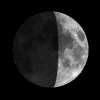Courtesy of EarthSky
A Clear Voice for Science
www.EarthSky.org

 As soon as darkness falls tonight, look for the planet Mars quite close to the moon, which reached its first quarter phase today at 1:20 p.m. Central Time. The moon and Mars remain close together throughout the night, and descend westward throughout the evening hours. These two worlds set beneath the western horizon in the wee hours after midnight.
As soon as darkness falls tonight, look for the planet Mars quite close to the moon, which reached its first quarter phase today at 1:20 p.m. Central Time. The moon and Mars remain close together throughout the night, and descend westward throughout the evening hours. These two worlds set beneath the western horizon in the wee hours after midnight.
The annual Lyrid meteor shower streaks the nighttime tonight from late night until dawn. The most Lyrid meteors are expected to fly in the dark hour before tomorrow’s dawn – or after the moon and Mars leave the starry sky. The Lyrids usually peak at about 10 to 20 meteors per hour. About one-quarter of these swift Lyrid meteors exhibit persistent trains – ionized gas trails that glow for a few seconds after the meteor has gone. The Lyrids are not an altogether predictable shower, and in rare instances can bombard the sky with up to 100 meteors per hour. The only way to catch such an unexpected outburst is to be outside watching.
These meteors appear to radiate from the constellation Lyra, not far from Lyra’s super-bright star, Vega. However, this is only a chance alignment. The Lyrids – bits and pieces from the Comet Thatcher – burn up in the Earth’s atmosphere about 100 kilometers – or 60 miles – overhead, while Vega lies some 25 light-years away. Nevertheless, you do not have to find Vega to enjoy the Lyrid meteors, for these meteors shoot all across the sky.
Tonight, the moon and Mars light up the nighttime from nightfall until after midnight, and the Lyrid meteors fly from late night until dawn. Expect to see the most Lyrids raining down in the predawn hours before sunrise tomorrow – or after the moon and Mars leave the sky. To watch the Lyrids, find a dark, safe spot and an open sky. Keep in mind that it takes about 20 minutes for your eyes to adapt to the dark. Meteor showers – like sporting events – have spurts and lulls, so give yourself at least an hour of viewing time.
Related:
The radiant of the Lyrid meteor shower
Lyrid meteors spring may still be flying before dawn April 23
EarthSky’s meteor shower guide for 2010
Looking for a sky almanac? EarthSky recommends . . .
Written by Bruce McClure
Other Links:
Astronomy Picture of the Day from NASA/JPL
U.S. Naval Observator Astronomical Information center